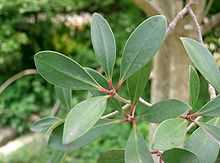Ternstroemia
| Ternstroemia | |
|---|---|
 | |
| Ternstroemia gymnanthera | |
| Scientific classification | |
| Kingdom: | Plantae |
| (unranked): | Angiosperms |
| (unranked): | Eudicots |
| (unranked): | Asterids |
| Order: | Ericales |
| Family: | Theaceae |
| Genus: | Ternstroemia Mutis ex L.f. |
Ternstroemia is a genus of flowering plants in the family Theaceae. It is distributed in tropical and subtropical regions in Africa, Asia, and the Americas.[1]
These are evergreen shrubs and trees. The leaves are alternately arranged, sometimes in clusters. Species are androdioecious, with some individuals bearing bisexual flowers and others with flowers that are functionally male. Flowers are solitary or borne in clusters. The flower has two bracteoles, five sepals, five petals, and many stamens. The berry-like fruit contains seeds that have red flesh over a thick endosperm. They are likely dispersed by birds.[1]
T. gymnanthera is an Asian species cultivated as an ornamental plant.[2][3] T. pringlei is one of the most widely used medicinal plants in Mexico.[4]
There are about 90 species in the genus.[1]
- Ternstroemia bullata Proctor
- Ternstroemia calycina Fawc. & Rendle
- Ternstroemia cherreyi
- Ternstroemia cleistogama Kobuski
- Ternstroemia corneri H.Keng
- Ternstroemia evenia (King) A.C.Sm.
- Ternstroemia glomerata Proctor
- Ternstroemia granulata Krug & Urb.
- Ternstroemia gymnanthera – Japanese ternstoemia, cleyera
- Ternstroemia heptasepala – saintedwood
- Ternstroemia howardiana Kobuski
- Ternstroemia landae Standl. & L.O.Williams
- Ternstroemia luquillensis Krug & Urb. – palo colorado
- Ternstroemia maclellandiana Ridl.
- Ternstroemia peduncularis – copey vera
- Ternstroemia penangiana Choisy
- Ternstroemia polypetala Melch.
- Ternstroemia pringlei
- Ternstroemia stahlii – mamey de cura
- Ternstroemia subsessilis (Britt.) Kobuski – el yunque colorado
- Ternstroemia tepezapote
- Ternstroemia wallichiana (Griffith) Engl.
References
- ↑ 1.0 1.1 1.2 Ternstroemia. Flora of China.
- ↑ Ternstroemia gymnanthera. North Carolina State University Extension.
- ↑ Ternstroemia gymnanthera. FloriData.
- ↑ Lozada-Lechuga, J., et al. (2010). Isolation of jacaranone, a sedative constituent extracted from the flowers of the Mexican tree Ternstroemia pringlei. Journal of Ethnopharmacology 127(2), 551-54.
- ↑ Ternstroemia. Integrated Taxonomic Information System (ITIS).
- ↑ GRIN Species Records of Ternstroemia. Germplasm Resources Information Network (GRIN).